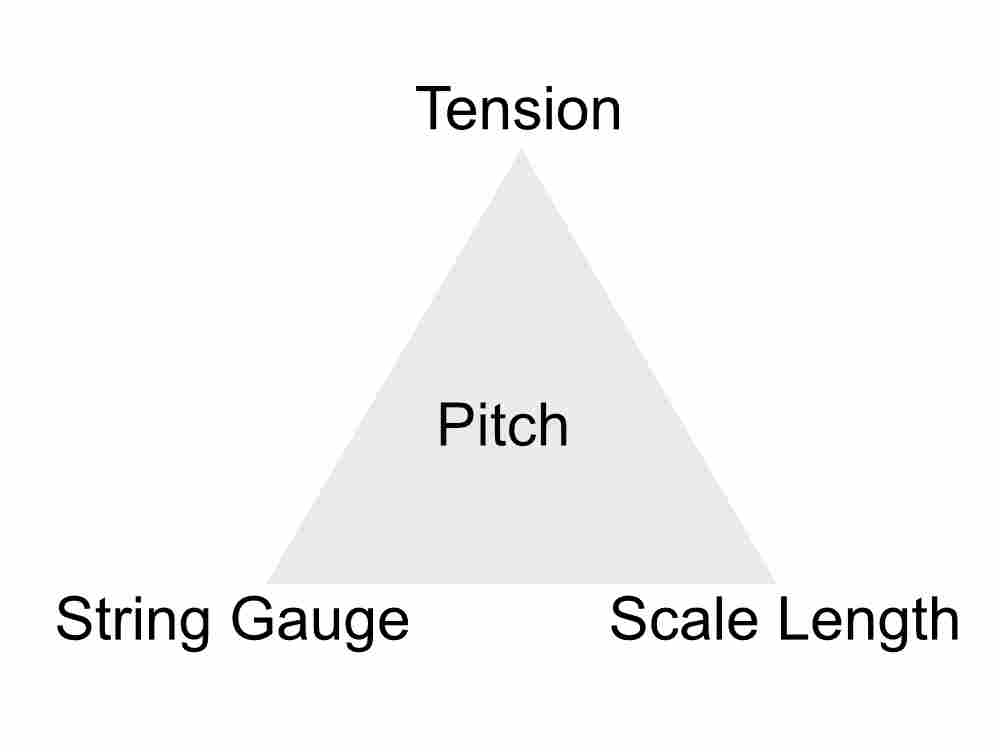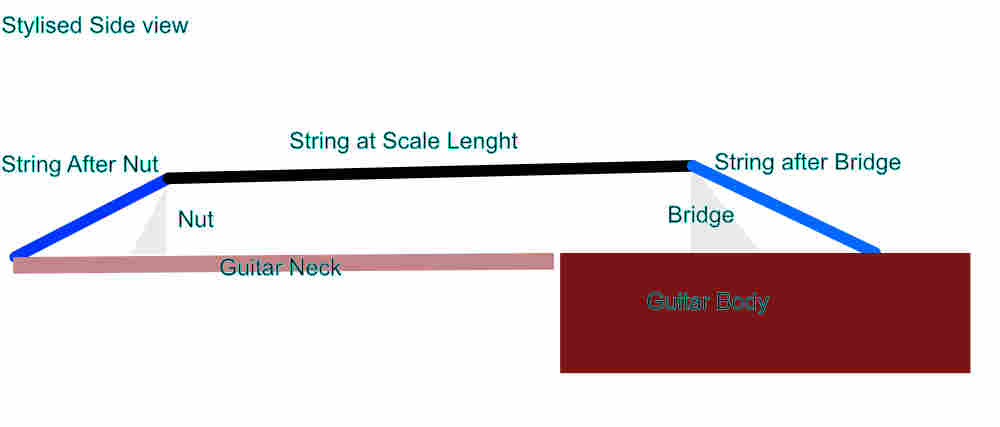

More than once, I heard about people changing their guitar’s setup or swapping from standard to Top wrapping on their bridge tailpiece in order to change their string tension and make it easier to play. Sorry to say, but although some of those changes might make it feel as though a guitar is easier to play, it doesn’t impact on string tension. If it did, you would have to tune the guitar so that it’s back in pitch, hence reverting the string tension to where it was.
There is a separate article on Top wrapping soon to be found “here” as it’s an interesting topic on its own merits. But let’s go back to talking about string tension.
As illustrated by the “Pitch triangle”, whenever you alter one element be it tension, gauge or scale length, you affect the Pitch. If you haven’t altered the string gauge or the scale length, and are keeping the same pitch, then whatever else you do at the bridge or headstock has no effect on the Tension. (Nor does the colour of your socks; which bizarrely is purple with lime stripes for me today. How did that happen?)
So why do people swear by some of these myths? Because they do perceive the benefits, really, they do. They are just verbally expressing what they feel and observe, and possibly drawing the wrong conclusions.
Here is a nice analogy for you: When you ride a bicycle and come to a hill, you might swap gears, and it makes it feel easier to pedal. The size of the hill and the incline hasn’t changed, but by changing gears you have to make many more “small efforts” rather than one big one. The effort exerted on a physical object to get it to move is generally called a “force”. So what we can do on a guitar by changing setups, by changing over to top wrapping or by fundamentally designing the guitar differently is give the player a different gear that makes his bends or playing feel like they require less force.
Now let us consider an imaginary string as represented on the Stylised side view guitar drawing. Our string starts at the headstock bit and travels over the nut. This first section is highlighted in blue. We then have the main part of the string which we play on and which is represented in Black. Finally, we have another Blue highlighted section that runs from the bridge contact point or saddle to the string anchoring point. The Blue sections do not play a role in the pitch of the string and if we had a locking clamp nut, and a fixed bridge with locking saddles, the actual string tension for a specific pitch would be the same as the same instrument with a standard nut and a 2 piece TOM style bridge. However, when you bend a string, you are applying extra tension, hence increasing the pitch. We rely on the “elasticity” of the string to stretch slightly as we bend it, and then return to the original length and pitch. This is where the “blue” sections come into their own. The longer a string is, the more we can find some elasticity to allow us to bend the string easier. If rather than clamped, our nut is allowing the string to slide over it easily, then all that length behind the nut and all the bit after the bridge contact point gives us extra elasticity in the same way a longer rubber band stretches further. So it’s this extra elasticity of the longer overall string that gives us the impression that we can bend easier.
There are however several things to take into consideration:
First, if the string moves over the nut and bridge as we bend, we need to make sure that the string can also return to its original state, or your guitar will be out of tune. Nuts need to be well cut, well polished and not too tight or they might bind. Same applies at the bridge, where the saddle needs to be nice and smooth. Some go as far as to equip these areas with rollers.
Second, if the breaking angle of the string over the nut and bridge is shallower, then the string will exert less friction on the contact point, so will be less likely to bind. The shallowest headstock Angle I have come across is only 4 degrees. It works great but is a long way from the 15 or even 17 degrees angled headstock found on some vintage necks ( those prone to breaking btw). Also when using a TOM style bridge, top wrapping allows not only a small amount of extra string length but drastically reduces the string break angle over the bridge contact point, so less friction.
Thirdly, the extra elasticity we are creating means that if we were to measure by how much our string needs to be laterally “bent” to change to a specific pitch, then we would see that we need to move our finger over a greater distance. That’s the bit that is similar to having to make more rotations of the pedal on your bicycle to reach the top of the hill.
And so we can conclude that while changing setup might not alter the string “tension”, it may indeed change how much “force” we need to play and bend strings.
Be assured you don’t actually have to worry about this stuff too much, but if you wonder why some guitars are “nicer” to play than others, rest assured there are reasons, not just Mojo. The job of guitar makers and techs is to understand what musicians are trying to tell us and devise strategies that support their playing and makes them happier.


